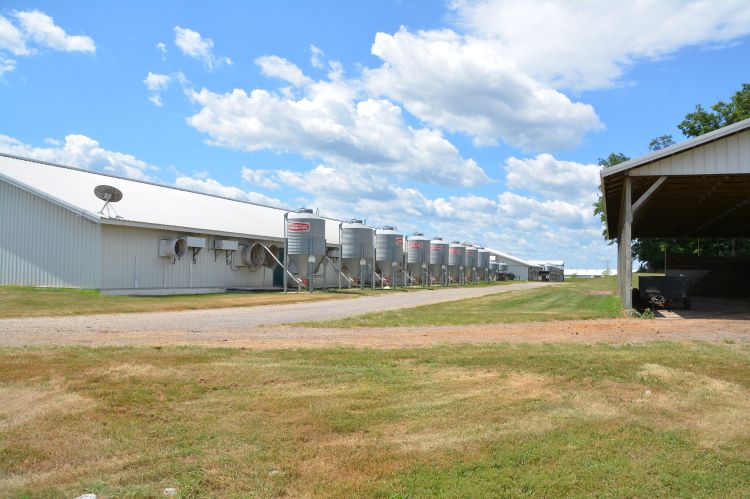From barn to breathing: Protecting human health in pork production
This article explores the critical links between swine production environments and the occupational health and safety of those who work within them.

Between operating heavy machinery, managing livestock and applying fertilizers, herbicides and pesticides, agricultural production involves a wide range of physical and chemical hazards. Some risks, like acute physical injuries, are easy to count. For example, non-cattle livestock accounted for 4.6% of reported injuries in Michigan in 2021, according to MSU’s Division of Occupational and Environmental Medicine. Other hazards, such as exposure to loud noises or airborne contaminants, are less immediately visible but can still cause significant long-term health effects when experienced repeatedly.
Key concerns in swine production include the risk of acute injury while lifting, bending, hauling or moving heavy materials or mortalities. In addition, repeated exposure to high decibels, particulate matter and airborne contaminants can also contribute to the development of chronic conditions such as respiratory illness or hearing impairment. Many of these risks can be mitigated with proper safety measures and consistent use of personal protective equipment (PPE).
Safe lifting and ergonomics
Lifting and hauling heavy loads can build strength when done with proper technique but doing so incorrectly may lead to injuries or contribute to long-term damage to joints and muscles. It is important to lift within your limits. Don’t reach, ensure firm footing and balance, stand as close as possible to the load and lift from the knees and core rather than your back. Be sure your path is clear of slip or trip hazards. Avoid bending or twisting the upper body while carrying. When setting the load down, bend from the knees and hips rather than the back.
OSHA provides helpful guidance on safe practices for lifting and workplace ergonomics. If a load is too heavy to lift safely on your own, see if another person can help, or use a dolly, cart, or lift. The AgrAbility Toolbox Assistive Technology Database also has specific equipment and adaptive tools designed to reduce physical strain in swine production.
Preventing noise-induced hearing loss
Loud noises in the work area, whether from machinery at the farm or large groups of animals in the barn, can cause more than just momentary discomfort. Over time, consistent exposure to high decibel levels can contribute to long-term impacts such as noise-induced hearing loss. Hearing loss is permanent, but noise-induced hearing loss is preventable.
Sound levels over 85 A-weighted decibels (dBA), a measurement adjusted for the sensitivity of human hearing) are considered hazardous (NIOSH). It's important to note that the decibel scale is logarithmic, not linear. This means a sound measured at 95 dBA is 10 times more intense than one at 85 dBA, comparable to the difference between a lawn mower and a chainsaw. Pigs can produce sound levels ranging from 100 to 115 dBA, well above the safe threshold, especially for more than a few minutes. NIOSH offers a free sound level meter app that may be helpful for monitoring workplace noise.
While eliminating exposure to high-decibel sounds may not always be realistic, especially in livestock barns or around equipment, wearing PPE consistently is crucial. Well-fitted earplugs or earmuffs should be worn correctly every time you’re in a high-noise environment to reduce long-term hearing risks.
Air quality
There are many airborne microorganisms, endotoxins and other particulates present in livestock barns. Their presence and persistence can vary based on ambient outdoor temperatures, humidity and atmospheric pressure. Air quality is another key consideration in any work setting that is enclosed, dusty, hazy or contains manure or other strong odors. Poor air quality in these environments can lead to irritation of the mucous membranes, acute or chronic bronchitis, occupational asthma and other respiratory conditions, according to Farming with a Respiratory Impairment 1994 by Cole et al. 2000.

Ventilation plays a critical role in hog barns, and most facilities already utilize fans and monitoring systems. Keep in mind that these systems contribute to background noise exposure, however. Operational changes, such as switching from ground to pelleted feed, can help improve air quality by reducing dust levels and may also enhance feed digestibility, according to Miller 2012.
Some tools for safer breathing include wearing a dust mask or an N95 mask during daily tasks. For those with prolonged exposure to barn air, a properly fitted respirator provides more protection. Respirators were once thought of as a clunky, inconvenient helmet-style piece of equipment, but modern versions have evolved significantly. Many now weigh less than one pound, rest comfortably behind the head and feature negative pressure-activated filtration systems that allow for extended wear in high-risk environments. Negative pressure activates the filtration system on the device that can be worn comfortably for a much longer period, which leads to safer breathing in high-risk environments. The AgrAbility Toolbox includes an example of a breathing-responsive HEPA respirator.
This list is far from all-encompassing, but it serves as a reminder to prioritize not only the health of the animals, but also the safety and respiratory health of the people who care for them. Preventive strategies, whether equipment-based or operational, can make a significant difference in long-term well-being and productivity.
This work was supported by the AgrAbility Competitive Program of the USDA National Institute of Food and Agriculture (NIFA), grant number 2022-41590-38121.
This information is for educational purposes only. Reference to commercial products or trade names does not imply endorsement by MSU Extension or bias against those not mentioned.



 Print
Print Email
Email




